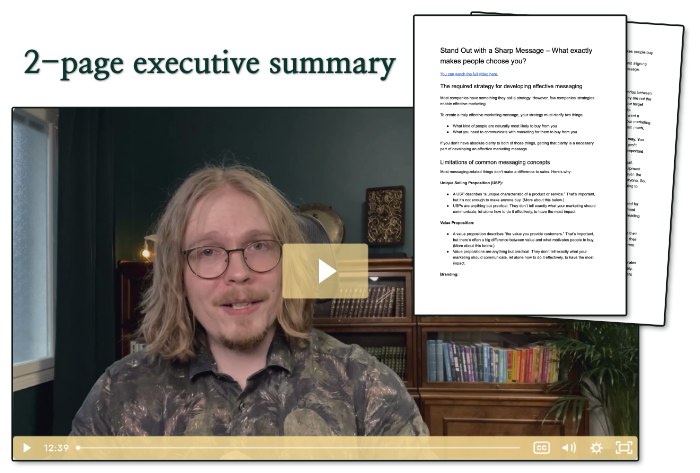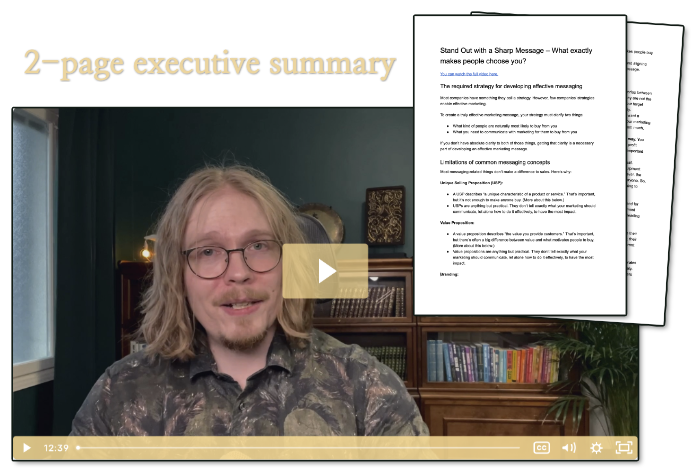You’ve seen the case studies. The endorsements. The hype. You know advertising can generate nearly limitless traffic. You can get more high-quality leads than you can handle.
But if you’re like most people, you haven’t seen those results in your business. Maybe you haven’t even advertised because you’ve seen the problems others have faced.
Advertising is one of the three methods for getting traffic and high-quality leads I recommend to most of my clients. So, let’s go through what you need to consider to know if you should use advertising. And if you do it, what you need to focus on to get results.
This is part 2 of the “How to get traffic and high-quality leads efficiently—3 most consistent methods for 99% of companies” series.
Part 1: Traffic is a vanity metric—here’s what pros track instead
Part 2: How to be smart about advertising and make a consistent profit
Part 3: How to choose the right advertising methods for your business
Part 4: How to write a guest post that attracts leads
Part 5: Partnership marketing methods—examples for all businesses
2 types of advertising
You can divide marketing into two categories: “branding” and “direct response.” Ads show the difference clearer than any other form of marketing.
An advertisement can aim to make people take an action immediately (e.g., sign up to a mailing list). That’s direct response marketing. Or it can aim to make people have a good impression of a company, product, or brand (e.g., most CocaCola ads). That’s branding. It’s not a binary thing; not all marketing is clearly one or the other. But if an ad doesn’t ask people to do something specific almost immediately, it’s branding.
If your company spends less than $1mil/year on marketing, go with direct response. It’s possible you could get good results with branding, but that’s a 1% chance.
The more you spend, the more likely it is that branding can create good results. If you get to $100mil/year, there’s maybe 5% chance branding would be more effective than direct response…
Making a profit with advertising has its complications anyway. Don’t make your odds worse by spending money on things you can’t even track (i.e., branding). Always ask people to do something immediately—something that moves them closer to buying.
Common ad hype vs. pros’ perspective to ads
You can easily find people talking about advertising. Some are excited about the latest test that improved their click-through-rates. There are some who talk about the incredible reach (how many people saw their ads). And the ones who rave about the traffic they got.
Listen to successful marketing experts talk about advertising, and you’ll notice a difference. They always mention profit. Even if they’re talking about CTR, reach, traffic, or anything else, they’ll almost certainly point out profitability. At least they know exactly how much they profited, even if they don’t want to share the numbers.
As a side note, using advertising to gain insights is a valid idea. And if that’s the goal, profit isn’t necessary. However, it’s rarely done well, so unless you really know what you’re doing, aiming for insights is risky.
If you don’t make a trackable profit with ads…why are you advertising? Do you have a good reason to expect the investment to come back later?
The main point about advertising is that you put money in and get more out. And the more money you put in, the more you get out (up to a point).
Advertising for the fun of it is an expensive hobby. If you just want to play around with fun marketing tools, try social media. It’s exactly like bad advertising: you can spend all the time you want doing it, and not make a profit. But at least you don’t pay for it.
Can you afford the initial risk?
Just because advertising can be effective for almost all businesses doesn’t mean it’s a smart option for you right now.
The main problem with advertising is that unless you make a profit—quickly—you can easily run out of money. There’s hardly a limit to how much you can spend on ads. Have $1,000 to spare? You can spend it in a day. Or 0.0067 seconds (average cost of a 30-second Super Bowl ad in 2015: $4.5mil).
The flip side is, of course, that if you make a profit, you can increase your ad budget and likely make a bigger profit. But there are no guarantees.
Some experts who have years of experience with advertising spend $10,000-20,000 before even knowing if they can make the ad profitable. So, their first $10-20K rarely get even close to breaking even. They’re happy if the last $1,000 is profitable.
A conversation with a couple of these top experts made me wonder what they do with that money. With the usual online methods, you don’t need anywhere near that much to see if the campaign can be profitable.
But the principle is real: You need to take a risk to find out if ads could work. In most cases the risk is around $300-800. If you can’t risk that, don’t try advertising.
If you can afford the risk, advertising is at least a viable consideration. That still doesn’t mean it’s a smart choice.
When advertising is smart (and when it’s not)
There are three distinct situations:
- You have a conversion path that generates a consistent profit.
- You have a conversion path that doesn’t generate a consistent profit.
- You don’t have a thought-through conversion path.
A conversion path is my term for a sales funnel. It’s not necessarily online or automated (like most funnels people talk about). It’s includes every step from reaching new potential customers to making the sales. Here’s a free training on conversion paths.
First option: If your path already consistently generates a profit when people get into it, you most likely should try advertising.
Second option: If your conversion path doesn’t generate a profit, advertising is unlikely to be profitable either. But if you just don’t have the statistics because so few people have gone through it, advertising can be a good idea. It’s a way to get lots of people to the path quickly, so you see the results. In general, though, I recommend testing the path without spending lots of money on traffic.
Third option: If you haven’t thought through your marketing system, why are you thinking about advertising? What would you advertise? How would it be profitable? Thinking about tactics (e.g., ads) before building out the conversion path is one of the most prevalent mistakes in marketing.
What to focus on when you do advertising
So, you’ve thought things through, and you’re about to start advertising. You want to be smart about it to have the best chance of getting good results. Here’s what you need to think of:
1. Select the right place for ads.
There’s a lot to consider. But here are the TOP 3 questions:
- “Will my target customers see my ad?”
- “Will they see it at a time when they can take the action I’m asking them to take?”
- “Will they see it at a place where they want to hear about the kind of thing I’m advertising?”
If they won’t see your ad, can’t take action, or don’t want to hear you out, you won’t get results. I’ll go through a bunch of advertising options in another article.
2. Create your advertisement.
I’ll have to write another article about this to give more practical instructions. But the basic steps are:
- Consider what kinds of ads are most likely to work best with the method you chose.
- Think of what can be the immediate “promise” that gets people interested (i.e., the first sentence).
- Think of how you can make people want to take the next step (e.g., join your email list).
- Write the content, select images, shoot video…and put the ad together.
The idea is that (1) you stick to the most effective types of ads, (2) focus on a strong promise and (3) give a clear reason for people to take the next step.
3. Make sure you’re targeting the right people.
This is a prerequisite for good results. The better the targeting, the better your results. So, in general, the more narrowly targeted, the better.
If you want to show your ads to lots of people, it’s better to set up separate ads for different groups (when possible), so you can track the results separately. For example, it’s common for ads to work very differently if you’re targeting USA compared to other western countries. If, in that case, you only have one big ad campaign, you might not notice that the ad only works in USA.
Location is only the most obvious targeting decision. Look through all the options the advertising method offers. If you show your ads to people who aren’t potential customers, you have no chance to make a profit.
4. Make sure you can track the results.
You need to see the exact profit you make from each ad. Not just each ad platform, campaign, or product. Track every single ad you run separately. And no, it’s not enough to check the click-through-rate or some other metric like that. You need to know the profit each ad generates—or lack there of. In the rare cases when that’s impossible, track another metric that predicts profits reasonably well. I usually use special URLs (Google’s utm codes) to set up ad tracking. They’re reliable enough and a fairly easy way to get the tracking to work with most marketing setups.
5. Check the results at least once a week.
You’re looking for a few metrics. Not all of them are the same for all types of advertising, though. The key things to look at are:
- How many people have seen a specific ad?
- How many of them have acted on it (e.g., clicked on a Facebook ad) and how much do you pay for one such action?
- How many of those people bought something?
- What’s the average purchase value?
- How much profit are you left with?
6. Optimize your advertising.
Just knowing the results doesn’t improve them. You need to act on the information.
The obvious part is to remove the ads that have poor conversion rates and don’t generate a profit. The other obvious part is to put more money into the ads that have good conversion rates and generate a profit.
The ads that have good conversion rates but aren’t profitable can sometimes become profitable with some tweaking (those tweaks vary greatly between advertising methods). Similarly the ads that have poor conversion rates, but are still profitable should be tweaked to improve the results.
7. Try new options when you have something working.
Just like with all marketing, you should focus on one thing at a time and make it work before moving to new things. Or that’s how I view it. I understand the temptation to throw lots of things at the wall and see what sticks. But it’s far less consistent. So, when your first ads work well, try other methods.
Series on getting traffic and high-quality leads
I usually recommend three methods for attracting traffic and leads to my clients. Advertising is the trickiest and riskiest of them. But it’s also so universally applicable and effective that a majority of companies should use it.
Before going to the other two methods, I’ll go through a selection of advertising methods.
This is part 2 of the “How to get traffic and high-quality leads efficiently—3 most consistent methods for 99% of companies” series.
Part 1: Traffic is a vanity metric—here’s what pros track instead
Part 2: How to be smart about advertising and make a consistent profit
Part 3: How to choose the right advertising methods for your business
Part 4: How to write a guest post that attracts leads
Part 5: Partnership marketing methods—examples for all businesses




